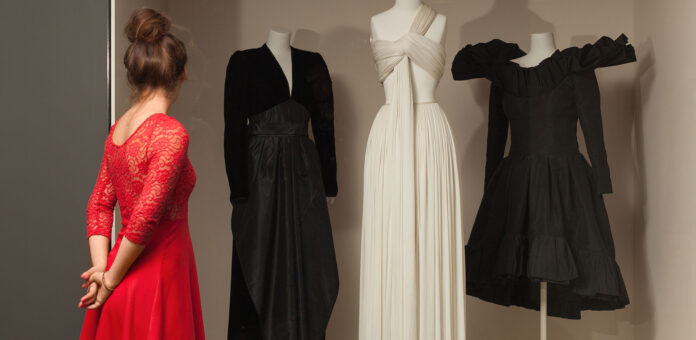The Kunstgewerbemuseum (Museum of Decorative Arts) houses world-renowned examples of European decorative and applied arts and design from the Middle Ages to the present. It collects, studies and communicates processes related to design, production and the use and/or appropriation of these artistic design objects. Moreover, it is dedicated to the relationship between people and the design of their environment, which it approaches from diverse perspectives.
Fashion Gallery
Several sections of the Kunstgewerbemuseum building, designed in 1966 by Rolf Gutbrod and opened in 1985, have been remodelled by the architectural firm Kuehn Malvezzi. The museum reopened in November 2014. The most extensive changes affected the Fashion Gallery. In large showcases installed in rooms lit dimly for conservation purposes, mannequins model some 130 costumes and accessories. Representing 150 years of fashion history, the installation conveys a sense of strolling through a shopping arcade, with the creations of famous couturiers such as Paul Poiret, Elsa Schiaparelli and Christian Dior in the windows. This is the first time Berlin has had a permanent exhibition covering every aspect of fashion. The core of the display is the international collection of Martin Kamer and Wolfgang Ruf, which was purchased in 2003.
Design Collection
The Design Collection shown on the lower level is a highlight. This top-quality selection presents Bauhaus classics alongside the designs of well-known contemporary designers such as Ettore Sottsass, Philippe Starck and Konstantin Grcic. A chair gallery rounds off the tour, featuring various innovative designs from the 19th century to the present. The chair illustrates the different possibilities of design better than almost any other object; here, the spectrum ranges from the simple and serviceable to the luxurious, culminating in designs where imagination completely overtakes functionality.
European Design and Object Art
On the ground and first floors, the museum systematically surveys European masterpieces of the minor arts from the Middle Ages to the early 20th century. Due to extensive remodelling, the exhibition spaces on the ground floor that usually display Medieval treasuries, including the renowned Welfenschatz (Guelph Treasure), alongside splendid Renaissance objects, such as the Lüneburger Ratssilber (the silver collection from the city of Lüneberg), are not accessible until 1 June 2024. Upstairs, the Baroque passion for collecting is exemplified in the phenomenon of the Kunstkammer – collections of exquisite curiosities and objets d’art housed in elaborate collectors’ cabinets. Exquisitely designed porcelain and faience objects reflect the refined aristocratic Rococo culture. The large cabinet by David Roentgen, an iconic masterpiece of its kind, marks the transition from Baroque to Neoclassical taste. The important Jugendstil section shows artistic tendencies that began with the Paris Exposition Universelle (World’s Fair) in 1900 and led well into the late 1920s. It includes numerous pieces of furniture, René Lalique’s jewellery and ornamentation and stained glass by César Klein.
A permanent exhibition of the Kunstgewerbemuseum, Staatliche Museen zu Berlin.
Source : Museen zu Berlin















